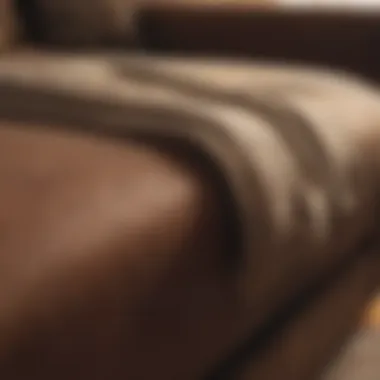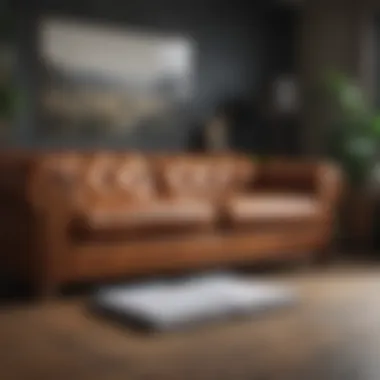Comprehensive Guide to Couch Cleaning Techniques


Intro
Couch cleaning is an essential aspect of home maintenance that is often overlooked. Many individuals do not realize the importance of keeping their upholstery clean and well-maintained. A couch can be a central piece in any living space, affecting not only the room's aesthetic but also the overall cleanliness and comfort of the home. Understanding the right techniques and methods for cleaning can greatly enhance both the look and lifespan of your furniture.
Following the right cleaning practices is crucial for various materials used in couches. Each fabric type requires different approaches in cleaning to avoid damage. In this guide, we will delve into the specifics of couch cleaning, offering strategies to tackle different types of stains, select the right products, and implement preventative measures for upkeep.
This article is designed to assist readers in ensuring their couches remain pristine. With step-by-step instructions and insights into effective methods, you'll find valuable information applicable to both your everyday cleaning needs and more challenging scenarios.Diving into this topic further enriches your knowledge, thereby promoting a healthier living environment in your home.
Understanding Your Couch Material
Understanding the material of your couch is fundamental in maintaining its cleanliness and longevity. Each fabric type has unique characteristics that affect cleaning methods, durability, and general upkeep. By knowing the specifics about your couch's material, you can make informed decisions when it comes to cleaning and protecting your investment. Selecting an inappropriate cleaning method for the fabric can lead to damage, discoloration, or deterioration. This section explores the common couch fabrics and how to identify them, ensuring you can proceed with confidence in your cleaning efforts.
Common Couch Fabrics
Leather
Leather is a classic choice for upholstery, appreciated for its sophistication. Its key characteristic is durability. Many prefer leather for its luxurious look and feel. However, it requires specific care; improper cleaning can result in cracking or a lack of luster. One unique feature of leather is its ability to develop a patina over time, adding character. The main disadvantage is its vulnerability to scratches, which may require professional intervention to restore.
Canvas
Canvas couches are typically regarded as casual and versatile. A key characteristic of canvas is its breathability, making it comfortable in warm climates. This fabric is also known for its sturdiness and is ideal for high-traffic areas. A unique aspect of canvas is that it can be easy to clean, but it does have a tendency to stain easily if not treated promptly. Users should be aware that frequent washing can impact color vibrancy.
Microfiber
Microfiber is an increasingly popular choice due to its remarkable softness and affordability. The key feature of microfiber is its resistance to stains and spills, making it a practical option for families or pet owners. A unique advantage is that it can mimic the texture of more expensive fabrics while remaining cost-effective. However, one drawback is that it can attract dust and lint, requiring regular maintenance to maintain its appearance.
Velvet
Velvet provides unmatched elegance and richness. Its key characteristic is its plush texture, which adds a level of comfort and luxury to any setting. A distinctive feature of velvet is its light-catching properties, offering a beautiful depth of color. The downside is that velvet can be challenging to clean. It tends to absorb moisture and can be damaged by rigorous scrubbing, making it crucial to identify the right cleaning products and methods.
Other Synthetic Fabrics
Synthetic fabrics, such as polyester or nylon, are known for their durability and ease of maintenance. A key factor in their popularity is their resistance to fading and staining, offering a long-lasting option for upholstery. Their unique feature is how they can blend different fibers for enhanced performance. However, synthetic fabrics can sometimes lack the luxurious appeal of natural fibers, a consideration for some consumers.
Identifying Your Couch Material
Knowing how to identify your couch material is equally important as recognizing the fabrics themselves. This section discusses two primary methods: checking labels and tags, and utilizing visual inspection techniques.
Labels and Tags
Labels and tags provide essential information about the couch material. A key characteristic is that they often indicate the cleaning methods suitable for that fabric. This is beneficial because it saves time in research and minimizes the risk of damage. A unique feature is the cleaning codes, such as "W" for water-based cleaning or "S" for solvent-based, which guide the cleaning process effectively. One disadvantage is that sometimes the labels are missing or worn, which can complicate identification.
Visual Inspection Techniques
Visual inspection is another vital method for identifying couch material. The key characteristic of this technique lies in its accessibility; anyone can perform it without special tools. Observing color, texture, and sheen allows a more learned guess about the fabric type. A unique feature is that some materials may reveal wear patterns or signs of damage, giving clues about their composition. However, some fabrics can closely resemble others, so caution is necessary when determining the right cleaning approach based solely on appearance.
Essentials of Couch Cleaning Supplies
Cleaning your couch effectively requires the right tools and products. Understanding which supplies to use can significantly enhance the cleaning process. Choosing the appropriate cleaning supplies not only aids in maintaining the couch's appearance but also extends its lifespan. The better you select these components, the more successful you will be in tackling dirt, stains, and any unwanted odors that may have accumulated over time.
Basic Cleaning Tools
Vacuum Cleaners
Vacuum cleaners play a crucial role in couch cleaning. They are designed to remove dust, debris, and loose dirt from surfaces. A vacuum cleaner equipped with upholstery attachments can reach crevices and upholstery textures that standard vacuums might miss. The key characteristic of vacuum cleaners is their efficiency in lifting away dirt without damaging the fabric. They are a popular choice because they save time and increase cleaning effectiveness.


The unique feature of vacuum cleaners is their ability to handle a variety of surfaces, making them versatile for different couch materials. However, one disadvantage may be that some vacuums could be heavy or difficult to maneuver in tight spaces, requiring consideration about the model used.
Soft Brushes
Soft brushes are another essential tool for couch cleaning. They serve to agitate the fabric gently, helping to dislodge dirt that may be trapped within fibers. The key characteristic of soft brushes is their gentle bristles, which are effective for delicate upholstery materials like velvet or certain synthetic fabrics. They are beneficial because they can be used without the risk of damaging or fraying the fabric. Soft brushes can be especially helpful in rejuvenating the look of a couch by refreshing its nap.
Nonetheless, the unique feature is that they require manual effort, which may result in longer cleaning time compared to mechanical options.
Lint Rollers
Lint rollers are useful for quick clean-ups. They effectively pick up pet hair, dust, and lint from couch fabrics. The key characteristic of lint rollers is their adhesive sheets, which allow for easy removal of debris without leaving residue. They are a popular choice for their convenience and portability, allowing users to keep one handy for regular touch-ups.
A unique feature of lint rollers is their disposable nature, which means they can be easily replaced when worn out. However, one downside is that they may not be suitable for deep cleaning; they should be used as a supplementary tool rather than a primary cleaning method.
Cleaning Products
Detergents
Detergents play a vital role in couch cleaning, especially for stain removal. They work to break down dirt and grease, making it easier to wash away stubborn marks. The key characteristic of detergents is their formulation, which can be specifically created for various fabrics. This makes them a beneficial choice, as using the right detergent can enhance cleaning results significantly.
Their unique feature is the ability to be diluted for different cleaning purposes, allowing users to create solutions tailored to their needs. However, certain types of detergent may leave residues if not rinsed properly, which requires attention during cleaning.
Fabric Softener
Fabric softener is often overlooked but plays a crucial role in couch cleaning. It helps to condition the fabric, making it feel softer and more comfortable. The key characteristic of fabric softener is its ability to reduce static cling and enhance texture. It is a beneficial choice for maintaining the feel of upholstery, especially for fabric couches.
A unique feature is that it can be used in the washing phase for removable covers, enhancing the overall appearance after cleaning. On the downside, some formulas may cause buildup over time, which could necessitate occasional deep cleaning.
Stain Removers
Stain removers are indispensable products for couch cleaning. These are specially formulated to tackle specific types of stains, such as oil, ink, or food. The key characteristic is their targeted action against different stains, which makes them effective. They are a popular choice because they can save furniture from permanent damage.
A unique feature is their concentration, making them powerful yet sometimes requiring careful application to avoid fabric damage. However, an important consideration is the need to follow instructions, as improper use may create additional stains or discoloration.
Natural Cleaning Solutions
Natural cleaning solutions have gained popularity among eco-conscious consumers. These cleaners are made from non-toxic ingredients, making them safe for both users and pets. The key characteristic is their environmental friendliness, which appeals to many homeowners. They are a beneficial choice for individuals looking to maintain cleanliness without harsh chemicals.
Their unique feature lies in their gentle yet effective cleansing properties, often making them suitable for various fabrics. However, the disadvantages include potential inefficacy on tough stains compared to chemical counterparts, which could limit their use in certain situations.
Preparation for Cleaning
Preparation for cleaning is a crucial phase in the couch cleaning process. Taking the time to assess the condition of your couch and identifying problem areas enhances the effectiveness of deep cleaning and maintenance. Good preparation helps in avoiding damage to the fabric and ensures that the cleaning products used are appropriate for the specific materials involved.
Understanding the specific needs of your couch before cleaning can save you time and reduce the risk of mishaps. It becomes easier to choose the right techniques and tools when you know the condition and fabric type of your furniture.
Initial Assessment
Examining Condition
Examining the condition of your couch is the first step in the initial assessment. It allows you to gauge how much cleaning is necessary. You should look for visible signs of wear, tears, and fading. This assessment helps to tailor your cleaning approach to fit the couch's requirements.
An important characteristic of examining condition is its comprehensive nature; it goes beyond just looking at the surface. You should also check under cushions and in seams where dirt tends to accumulate. Failure to do so could result in incomplete cleaning and lingering odors.
One unique feature of this examination is that it can highlight structural issues like broken frames or loose supports. Identifying these before cleaning can prevent further damage during your cleaning process. However, if condition assessment is neglected, it can lead to the use of harsh chemicals on delicate fabrics or techniques that worsen the issue rather than resolve it.


Identifying Problem Areas
Identifying problem areas involves locating specific spots on the couch that require focused attention. Common problem areas include the arms of the couch, the seat cushions, and areas where pets may have laid. Recognizing these zones allows for targeted cleaning efforts that can be more effective.
A key feature of identifying problem areas is its preventive potential. By addressing these spots promptly, you can avoid stains setting in and creating permanent discoloration over time. It is a beneficial practice, especially if you regularly use your couch.
However, a disadvantage can arise if the focus is limited strictly to visible stains. Sometimes, internal issues such as mold growth or allergen accumulation can be overlooked. Such oversights can have longer-term implications for the couch's hygiene and your home environment.
Gather Necessary Materials
Collecting Tools and Supplies
Collecting tools and supplies is a vital part of the preparation process. Having all necessary items at hand can streamline the cleaning process and prevent interruptions. Essential tools often include vacuum cleaners, soft brushes, and lint rollers which are designed to tackle specific cleaning tasks effectively.
A prominent characteristic of gathering materials is that it prepares you for all possible scenarios during the cleaning session. Think of this as assembling an arsenal to deal with the couch’s needs efficiently. It reduces the likelihood of needing to pause for further purchases or searches for the right tool.
One unique aspect of this collection is the flexibility it offers. With the proper tools, you can adapt to various situations, like removing stubborn stains or maintaining fabric texture. However, having too many unnecessary tools can complicate the process and create confusion about the best approach to take.
Creating a Cleaning Station
Creating a cleaning station is another essential step in preparation. This involves organizing your materials in a designated space that allows you to work comfortably and efficiently. A well-structured cleaning station aids in keeping track of supplies and minimizes time wastage.
The effectiveness of a cleaning station lies in its arrangement. By organizing tools and cleaners categorically, you can easily access what you need without disruption. It promotes efficiency, ensuring that your cleaning session is focused entirely on restoring your couch rather than searching for misplaced items.
A notable feature of having a cleaning station is that it can include various cleaners that suit different materials, like leather-based or microfiber products. Not having such a setup can lead to chaos during the cleaning process, which might result in rushed work and subpar results.
Basic Couch Cleaning Techniques
Cleaning your couch should not be a daunting task. Understanding basic couch cleaning techniques is essential for maintaining the appearance and longevity of the upholstery. Regular cleaning helps in removing dirt, dust, and allergens. It also maintains the fabric's color and texture. A well-maintained couch enhances the overall aesthetics of your living space. Moreover, addressing stains promptly can prevent permanent damage and costly repairs or replacements.
Vacuuming the Couch
Technique and Method
To effectively vacuum your couch, use a vacuum cleaner with a brush attachment. This method allows for a thorough clean. Start from one end and move systematically to the other, ensuring you cover all surfaces, including cushions and under them. Be sure to use low suction for delicate fabrics, which helps avoid damage. This technique is popular because it is quick and requires minimal equipment. However, it may not remove deep-seated dirt or stains completely. For optimal results, consider complementing vacuuming with other cleaning methods.
Frequency Recommendations
Frequency of vacuuming is vital. Ideally, you should vacuum your couch at least once a week. Regular vacuuming prevents the build-up of dust and grime. If you have pets, consider vacuuming more often due to fur accumulation. A consistent routine ensures that the couch remains clean and inviting. Not vacuuming regularly can lead to tough stains and odors that require more intensive cleaning. Thus, timeliness in cleaning is key for long-term maintenance.
Spot Cleaning Stains
Familiar Stain Types
Understanding common stain types is necessary for effective spot cleaning. Familiar stains include food spills, pet accidents, and grease marks. Each type demands a specific approach. For instance, water-based stains can often be removed with mild detergent and water. On the other hand, oil-based stains require specialized cleaning agents. Identifying stains quickly can make a significant difference in the cleaning outcome. Regular knowledge of these stains is beneficial as it allows for a more efficient response to cleaning emergencies.
Appropriate Cleaning Methods
Using the right cleaning method is crucial. For example, blotting with a clean cloth is often effective for liquid spills. This technique absorbs moisture without pushing the stain deeper into the fabric. Alternatively, rubbing can make certain stains worse. Hence, knowing the method that corresponds with the type of stain you are dealing with is essential. Taking a moment to understand various cleaning methods with proper techniques often yields the best results. Keeping a selection of cleaning agents on hand can further enhance your ability to manage stains in real time.
Deep Cleaning Your Couch
Deep cleaning your couch is an essential task that goes beyond basic maintenance. It addresses accumulated dirt, allergens, and stubborn stains that regular cleaning might miss. The value of deep cleaning lies in its ability to refresh the appearance and extend the lifespan of your upholstery. With different materials and usage patterns, couches can harbor unseen issues over time. This process not only improves aesthetics but also promotes a healthier living environment.
Steam Cleaning


Equipment Needed
To effectively steam clean your couch, specific equipment is necessary. A reliable steam cleaner is the centerpiece of this task. These devices generate high-temperature steam that penetrates fabric fibers, loosening dirt and killing bacteria. Many steam cleaners have attachments designed for upholstery, ensuring optimal performance. One distinct advantage of using steam cleaning equipment is its eco-friendliness, as it requires little to no chemicals.
However, it's important to consider the unique needs of your couch material. For example, leather cannot withstand the same treatment as synthetic fabrics, therefore verifying compatibility is crucial. A handheld steamer can be an efficient choice for smaller areas or tight spots, though it may not provide the same thoroughness as larger units.
Procedure Overview
The procedure for steam cleaning your couch requires a systematic approach for effectiveness. Start by vacuuming to remove loose debris and dust, setting the stage for deeper penetration. Following this, prepare the steam cleaner according to the manufacturer’s guidelines. This usually involves filling the tank with water and attaching the upholstery tool.
Once ready, apply the steam evenly across the upholstery, ensuring to focus on heavily soiled areas. The key characteristic of this method is the speed at which it works, allowing for faster drying than most wet cleaning methods. However, over-soaking with steam can lead to water damage, so caution is vital. It is beneficial to test a small, inconspicuous area first to ensure colorfastness
Professional Cleaning Services
When to Hire Professionals
Sometimes, your couch may require a professional touch. Situations that warrant hiring professionals include persistent stains that resist home cleaning attempts, or if the fabric is particularly delicate. Professionals possess advanced equipment and expertise that can effectively tackle difficult cleaning issues.
Additionally, if your couch has not been cleaned for a long time, a deep professional cleaning may restore its former glory. The convenience of hiring professionals allows you to focus on other tasks while getting effective results without risk of harm to your furniture.
Selecting a Reputable Service
Choosing a reputable cleaning service is critical to ensure effective results. Research local options and look for services specializing in upholstery cleaning. Reading reviews and requesting referrals can help identify highly-rated providers. The key characteristic of a good cleaning service includes having experienced technicians who understand various fabrics.
Further, asking about cleaning methods can reveal whether their processes are environmentally friendly and safe for your household. Comparing quotes and services offered is also beneficial, as it helps you find a balance between affordability and quality. Equip yourself with all necessary information before making a decision.
Consider: Regularly deep cleaning your couch can enhance its longevity and keep your home environment healthy.
Post-Cleaning Maintenance
Maintaining a couch after a cleaning session is critical for preserving its appearance and prolonging its lifespan. With the right post-cleaning strategies, you can ensure that the effort put into cleaning does not go to waste. This section discusses the significance of adhering to post-cleaning maintenance, as well as practical tips and methods that contribute to a sofa's durability and visual appeal.
Regular Maintenance Tips
Scheduled Vacuuming
Scheduled vacuuming is an essential practice for every couch owner. This involves setting aside specific times to vacuum the sofa regularly, avoiding the accumulation of dust and crumbs. The effectiveness of this routine is evident in its ability to maintain a clean surface, which can greatly enhance the overall look of a couch. Regular vacuuming not only helps in keeping the couch free of debris but also prevents stains from taking hold.
The most prominent characteristic of scheduled vacuuming is its consistency. It is beneficial because it creates a habit of cleanliness. Many homeowners find that integrating this step into their routine leads to a more appealing living space. One unique feature of this approach is the ease with which it can be implemented.
There are some disadvantages, such as time commitment. Some might neglect this task, which can lead to a more challenging cleaning job later on. Nonetheless, the advantages usually outweigh the cons when a proper vacuuming schedule is adhered to.
Immediate Stain Treatment
Immediate stain treatment addresses spills and accidents right away. This is vital in maintaining the integrity of the fabric and preventing permanent damage. The key aspect of immediate stain treatment is its promptness; acting quickly can often make the difference between a stain that cleans up well and one that becomes a permanent fixture.
One of the main reasons for its popularity is its effectiveness in preserving the couch's condition. By treating a stain before it sets, homeowners can avoid the need for more intensive cleaning later. A unique feature of this method is the use of household items like club soda or vinegar, which can be just as effective as commercial products.
However, a potential disadvantage lies in the lack of knowledge about how to treat certain types of stains. Some individuals may choose inappropriate cleaning methods that exacerbate the problem. Therefore, it’s crucial to understand the proper techniques when dealing with spills.
Protective Measures
Using Fabric Protectors
Using fabric protectors is a proactive approach to couch maintenance. These substances create a barrier against spills and stains, aiding in the preservation of the couch's fabric. The core characteristic of fabric protectors is their preventive capability. Employing them is a favorable choice because they can make routine maintenance much easier.
One unique aspect of fabric protectors is their ability to repel liquids. When applied correctly, they can significantly reduce the risk of staining from everyday spills. Some might argue that using these products can be an added expense, but the long-term benefits of greater fabric lifespan usually justify the initial investment.
Cover Options for Couches
Cover options for couches serve both functionality and style. These covers not only protect the underlying fabric from potential damage but can also enhance the overall aesthetics of the room. They come in various materials and designs, making it easy to choose one that complements existing decor. Covers act as a shield against everyday wear and tear, aligning perfectly with the goals of this article.
A key characteristic of couch covers is their versatility. They are easy to remove and clean, which adds to their appeal. However, the unique design and fit may vary. Some covers may not stay in place securely, leading to a need for periodic readjustment. Still, the protective benefits generally outweigh such minor inconveniences, making covers a popular choice in couch maintenance.







